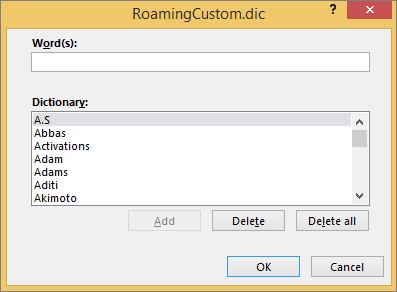Adding Medical Dictionary To Microsoft Word For Mac
- Adding Medical Dictionary To Microsoft Word For Mac Pdf
- Free Microsoft Word For Mac
- Dictionary Downloads For Microsoft Word
- Medical Dictionary For Microsoft Word
- Adding Medical Dictionary To Word
With Office 2011 for Mac, you can check spelling and grammar in languages other than English. Word 2011 for Mac comes with foreign-language dictionaries such as Czech, French, Russian, and more. The default dictionary determines which language’s proofing tools Word uses for spelling and grammar.
You can change Word’s default language dictionary:
Choose Tools→Language.
The Language dialog opens, and you see a list of languages.
Select the new language to use and click the Default button.
Click Yes to change Word’s default spelling and grammar checking language to the language you selected.
Click OK to close the Language dialog.
Adding Medical Dictionary To Microsoft Word For Mac Pdf
There may come a time where you want to use a different language for only a portion of your document. You can also use the Language feature to change the language of just the selected text:
Free Microsoft Word For Mac
Now e-medtools.com a site which specialises in medical spell checking, medical proformas and PDA software have made a 40 000 word dictionary available for free under the GPL licence. Up until their product for MS word was only available with a $10 single user licence. Add your own medical words to the Microsoft Word custom dictionary. Word is set up for that. Advantages: It's free. You can pick and choose which words to add to it. And you'll gain experience working with Word. It's a lot of work. And it can take forever, but you might need medical spelling help right now. The Dictionary.app application in Mac OS X Leopard allows for the use of plug-ins. Does anyone know if a medical dictionary plug-in for Dictionary.app currently exists or is being developed? If not, is anyone interested in helping put one together?
Select a word or passage in the text.
Choose Tools→Language from the menu bar.
Select a language to use.
Click OK to close the Language dialog.
Choose Tools→Spelling and Grammar.
The selection will have a different spelling and grammar language applied to them and will be checked against the proofing tools for the language selected using the Language dialog. The rest of the document will be checked against Word’s default spelling and grammar language.
Making these modifications to the Language setting doesn’t change the language that’s used for the Office interface. If you want the entire Office interface to be in a particular language, you have to purchase and install an Office version that’s customized for the particular language you want to use.
Word 2011 for Mac lets you create, edit, and add new dictionaries to its collection of dictionaries. Perhaps your discipline, science, or profession uses a lot of specialized terms not found in the Word default dictionary, or maybe you need to add a dictionary for a language not supplied with Office 2011 for Mac.

A dictionary is simply a list of words with a paragraph mark after each word (created by pressing Return or Enter) in which the words are saved as a file with a .dic extension. Dictionary files aren’t different for Mac or Windows, but beginning with Word 2011, Word on the Mac may demand dictionaries that were saved a special way in order to support UniCode fonts.
You can find custom dictionaries and foreign language dictionaries on the Internet by searching for them, and many are free.
Dictionary Downloads For Microsoft Word
To add a custom dictionary file, take these steps:
Choose Word→Preferences from the menu bar.
In the Authoring and Proofing Tools section, choose Spelling and Grammar.
In the Spelling section, click the Dictionaries button.
Click the Add Button.
Navigate to the .dic dictionary file and select it.
If the .dic file you want to use is grayed out, switch the Enable pop-up menu to All Files.
Click Open.
Your custom dictionary appears with a check box that’s selected in the Custom Dictionaries dialog.
Click OK to close the Custom Dictionaries dialog and then click OK to close the Spelling and Grammar preferences pane.
Your new dictionary is now available to Word, Excel, and PowerPoint. Outlook uses the Mac OS X dictionary.
Editing a custom dictionary in Word 2011 for Mac
Because dictionaries are simply text files, you can open them in Word, add and remove words, and save them again. If you ever accidentally add a misspelling to a custom dictionary or if you want to add or remove words, follow these steps:
Medical Dictionary For Microsoft Word
In Word, choose File→Open.
Select All Files from the Enable pop-up menu.
Choose the .dic file you want to use and click Open.
Click the Show button on Word’s Standard toolbar to toggle on the ability to see paragraph marks if they aren’t showing already.
Add or remove words from the list.
Click the Save button on Word’s Standard toolbar to save your changes; then click the Close button to close the document.
Making a new custom dictionary in Word 2011 for Mac
If you found a list of words, or you don’t mind typing your own list, you can start from scratch with an empty dictionary, and then add your list to it using the steps to edit a dictionary from the previous section. Here’s how to make a new, blank custom dictionary:
Adding Medical Dictionary To Word
Choose Word→Preferences from the menu bar.
Microsoft word printing problems machines. In the Authoring and Proofing Tools section, choose Spelling and Grammar.
In the Spelling section, click the Dictionaries button.
Click the New Button.
Give your dictionary a name and then save it.
Click OK to close the Custom Dictionaries dialog and then click OK to close the Spelling and Grammar preferences pane.
Your new, empty dictionary is now available to all Office applications.